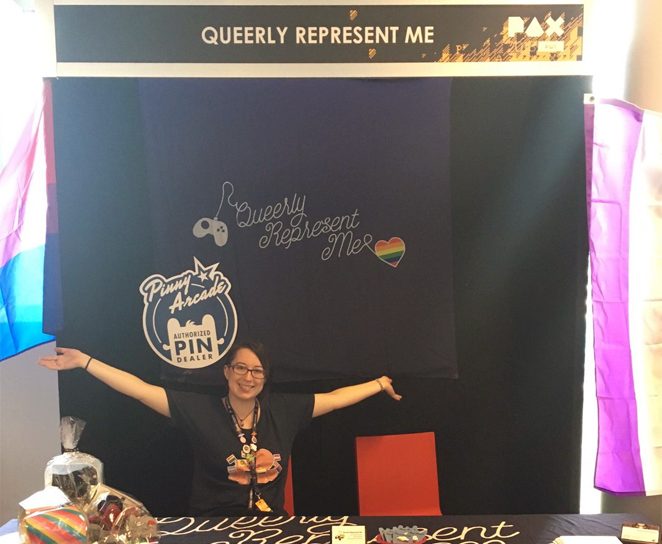The PAX Diversity Lounge shows us there are no easy answers for creating safe spaces

- November 7, 2018
Alayna Cole
Alayna Cole is a producer at Sledgehammer Games and the managing director of Represent Me. She champions diversity and inclusion in the games industry, with a particular research focus on LGBTQ+ representation. Alayna co-wrote 'Cooperative Gaming: Diversity in the Games Industry and How to Cultivate Inclusion' and 'Games as Texts: A Practical Application of Textual Analysis to Games', is a co-chair of the IGDA LGBTQ+ special interest group, and holds a doctorate of creative arts.
In 2013, Penny Arcade announced that they would be introducing a ‘Roll for Diversity’ lounge to the PAX convention in their Seattle, Boston, and Melbourne venues. Leaked documents about the initiative implied that it would lead to the segregation of diverse discussions and groups from the rest of the conference, and people on the internet were angry. The resounding question was: why do we need to create a safe, segregated space for discussions of diversity when we could be focusing on making the whole of the PAX convention safe for marginalised people?
The conversation around diversity in games has shifted significantly in the last five years, to the point where people are wondering why the conversation is even still happening. Marginalised people are sick of being invited onto panels to speak about their marginalisation more often than about their actual work, diversity 101 talks are being upgraded to explore more nuanced and interesting facets of the topic, and consultation on how to make projects more inclusive and accessible is becoming more common. But the Diversity Lounge still exists, and remains almost identical to the space that was originally created in 2013. Should this initiative be evolving to match the changing conversation? Is it still necessary? Was it ever?
At PAX Australia 2018, my charity—Represent Me—was lucky enough to be given a community booth in the Diversity Lounge. We spent the weekend increasing awareness of our group, educating people on how to be better allies, and helping the queer community feel heard. We were also able to successfully raise funds to support some of our ongoing work, which was amazing considering we were not required to pay anything to have our booth.
Anybody who’s ever looked into the cost of getting a booth on the PAX showfloor would know that it is not cheap. Even with initiatives like PAX Rising existing to support indie developers with limited income, or the NEXT exhibit that was introduced this year in Melbourne to give marginalised developers a space to show their work, it can be difficult for people to reach the thousands of patrons that walk through the convention hall on PAX weekend. Making the Diversity Lounge booths free for community groups who are seeking to help marginalised people is an excellent move on PAX’s part and, without that support, we would not have been able to attend PAX at all.
But we definitely felt segregated from the main show, as people feared would happen way back in 2013. To reach us, you had to go into a different building from the main showfloor, pass the queues to the main theatre, and climb two sets of stairs (past a ‘Keep Going!’ sign to encourage those who were confused by the empty, quiet areas on the way). We were near the three smaller theatres—Galah, Kookaburra, and Ibis—where diversity-related talks are also often held. It was like we were put in the ‘diversity wing’, which people could entirely avoid if they wanted a diversity-free show.
That said, it was nice to have a quiet area. People actively commented on how the Diversity Lounge is a pleasant, safe space for them because it isn’t as loud and crowded as other areas of the show, and that was something I noticed whenever I went down the escalators for a short break. There is definitely a need for those quieter spaces where people can play a boardgame and feel like they can hear themselves think. But does that quieter space also need to be where the diversity talks, community groups, and gender neutral bathrooms are tucked away? For me, that reinforces the idea that there is the ‘normal’ main showfloor and theatre and the ‘other’ booths and theatres. How much more traffic would our community groups receive if they were more obvious to all PAX attendees? How many more people could we educate? How many more funds could we raise?
Overall, I have mixed feelings. It’s good that there’s a place where marginalised people can feel safe, but how can we also improve the overall safety of PAX itself? It’s good that diversity is still being talked about, but how can we progress those conversations and ensure they don’t feel segregated? It’s good that community groups are given free access to the publicity that PAX provides, but how can we make sure that everyone sees them and benefits from them being present?
How do we stop separating marginalised people from homogenous gamer culture and instead make us an unavoidable part of it?
